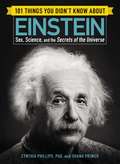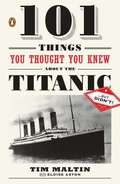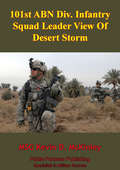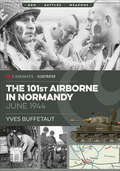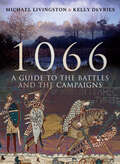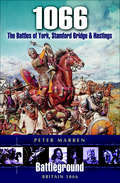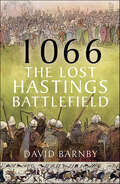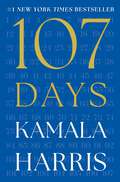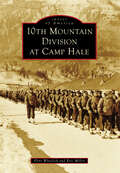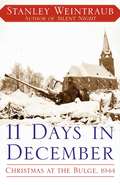- Table View
- List View
101 Things You Didn’t Know about Da Vinci: Inventions, Intrigue, and Unfinished Works (101 Things)
by Cynthia Phillips Shana PriwerTimed to coincide with the release of Walter Isaacson’s latest biography on the famous painter and inventor, as well as the latest thriller in Dan Brown’s Da Vinci Code series, this book includes 101 in-depth facts about Leonardo Da Vinci.101 Things You Didn’t Know About Da Vinci provides you with all the fascinating facts you didn’t know about the famous artist, inventor, and creator of the Mona Lisa and the Vitruvian Man, including details about his personal life, information about his inventions and art, his interactions with his contemporaries, and his impact on the world since his death. Some facts include: —Da Vinci was left handed, and wrote from right to left, even writing his letters backwards. —Da Vinci’s The Last Supper started peeling off the wall almost immediately upon completion, due to a combination of the type of paint Leonardo used and the humidity —Among Leonardo’s many inventions and creations was a mechanical lion he created to celebrate the coronation of King François I of France Whether you’re seeking inspiration, information, or interesting and entertaining facts about history’s most creative genius, 101 Things You Didn’t Know About Da Vinci has just what you’re looking for!
101 Things You Didn’t Know about Einstein: Sex, Science, and the Secrets of the Universe (101 Things)
by Cynthia Phillips Shana PriwerLearn everything you need to know about Albert Einstein, the genius who created the Theory of Relativity and calculated mass-energy equivalence.101 Things You Didn’t Know About Einstein provides in-depth, fascinating facts about the famous scientist and mathematician—including details about his personal life, scientific discoveries, interactions with his contemporaries, thoughts on war, religion, and politics, and his impact on the world since his death. Whether you’re seeking inspiration, information, or interesting and entertaining trivia, this book contains everything you need to know about Albert Einstein!
101 Things You Need to Know About Suffragettes
by Maggie Andrews Janis LomasSuffragettes learned jiu-jitsu, repelled policemen with their hatpins, burnt down football stadiums and planted bombs. They rented a house near to Holloway Prison and sang rebel anthems to the Suffragettes inside. They barricaded themselves into their homes to repulse tax collectors. They arranged mass runs on Parliament. They had themselves posted to the Prime Minister, getting as far as the door of No. 10. Indomitable older members applied for gun licences to scare the government into thinking they were planning a revolution. Rebels. Warriors. Princesses. Prisoners. Pioneers. Here are 101 of the most extraordinary facts about Suffragettes that you need to know.
101 Things You Thought You Knew About the Titanic . . . but Didn't!
by Tim MaltinApril 15th, 2012, will be the 100th anniversary of the sinking of the Titanic. People have an endless fascination with the Titanic, yet much of what they know today is a mixture of fact and fiction. In one hundred and one brief and engaging chapters, Tim Maltin, one of the foremost experts on the Titanic, reveals the truth behind the most common beliefs about the ship and the night it sank. From physics to photographs, lawsuits to love stories, Maltin doesn't miss one tidbit surrounding its history. Heavily researched and filled with detailed descriptions, quotes from survivors, and excerpts from the official inquiries, this book is guaranteed to make readers rethink everything they thought they knew about the legendary ship and its tragic fate.
1014: Brian Boru & the Battle for Ireland
by Morgan Llywelyn"A deftly written history that reads as smoothly as a novel." — Midwest Book ReviewIn life, the eleventh-century Irish king Brian Boru held the Vikings at bay; in death, he remains a towering presence in history and legend. A thousand years have passed since the Battle of Clontarf, a turning point in Irish history in which two centuries of strife between Irish kings and Vikings climaxed in a fateful conflict in the swamps of Dublin. This fascinating survey explores the personalities on both sides and provides a vivid, accessible account of the historic clash.Morgan Llywelyn, author of the bestselling Lion of Ireland, ranks among the world's most successful and respected historical novelists writing about Ireland and Celtic culture. With this book she departs from fiction to transmit decades of research into a page-turning exploration of a warrior king's life, loves, and battles, bringing the facts to life with a novelist's eye for detail and drama."Llywelyn's account is one of the most readable and dramatic on the subject. She brings the complexities of the Irish chieftain and inheritance systems to life and shows us how decisive the famous battle turned out to be." — Irish Voice
101st ABN Div. Infantry Squad Leader View Of Desert Storm (Eyewitness To Modern War #6)
by MSG Kevin D. McKinleyThis paper will provide a historical view of the events of 1st Squad, 1st Platoon of Bravo Company, 2/187th Infantry BN, 101st ABN Division, Fort Campbell, KY. I will provide insight of the operation from the squad level non-commissioned officer view. I will focus on the areas of notification of deployment, pre deployment preparation, deployment, Operation Desert Shield, Operation Desert Storm, cease-fire, and redeployment to Fort Campbell. The paper will cover the period of 01 August 1990 through 09 April 1991.
101st Airborne in Normandy: June 1944 (Casemate Illustrated #1)
by Yves Buffetaut101st Airborne Division was activated in August 1942 in Louisiana, and its first combat mission was Operation Overlord. On D-Day—June 6, 1944—101st and 82nd Airborne dropped onto the Cotentin peninsula hours before the landings, tasked with capturing bridges and positions, taking out German strongpoints and batteries, and securing the exits from Utah and Omaha Beaches. Things did not initially go smoothly for 101st Airborne, with cloud and antiaircraft fire disrupting the drops resulting in some units landing scattered over a large area outside their designated drop zones and having to waste time assembling—stymied by lost or damaged radio equipment—or trying to achieve their objectives with severely reduced numbers. Casualties were high in some areas due to heavy pre-registered German fire. Nevertheless, the paratroopers fought on and they did manage to secure the crucial beach exits, even if they only achieved a tenuous hold on some other positions. A few days later, 101st Airborne were tasked with attacking the German-held city of Carentan as part of the consolidation of the US beachheads and establishment of a defensive line against the anticipated German counteroffensive. The 101st forced their way into Carentan on 10 and 11 June. The Germans withdrew the following day, and a counteroffensive was put down by elements of the 2nd Armored Division. This fully illustrated book details the planning of the airborne element of D-Day, and the execution of the plans until the troops were withdrawn to prepare for the next big airborne operation, Market Garden.
102 Minutes: The Untold Story of the Fight to Survive Inside the Twin Towers
by Jim Dwyer Kevin FlynnAt 8:46 am on September 11, 2001, 14,000 people were inside the twin towers-reading e-mails, making trades, eating croissants at Windows on the World. Over the next 102 minutes, each would become part of a drama for the ages, one witnessed only by the people who lived it-until now. <P><P> Of the millions of words written about this wrenching day, most were told from the outside looking in. New York Times reporters Jim Dwyer and Kevin Flynn have taken the opposite-and far more revealing-approach. Reported from the perspectives of those inside the towers, 102 Minutes captures the little-known stories of ordinary people who took extraordinary steps to save themselves and others. Beyond this stirring panorama stands investigative reporting of the first rank. An astounding number of people actually survived the plane impacts but were unable to escape, and the authors raise hard questions about building safety and tragic flaws in New York's emergency preparedness. <P><P> Dwyer and Flynn rely on hundreds of interviews with rescuers, thousands of pages of oral histories, and countless phone, e-mail, and emergency radio transcripts. They cross a bridge of voices to go inside the infernos, seeing cataclysm and heroism, one person at a time, to tell the affecting, authoritative saga of the men and women-the nearly 12,000 who escaped and the 2,749 who perished-as they made 102 minutes count as never before. 102 Minutes is a 2005 National Book Award Finalist for Nonfiction.
103 Journeys, Voyages, Trips and Stuff
by Siddhartha SarmaFrom ancient civilization to modern times, the experience of journeys by road, water and air is recounted by the author.
1066 and Before All That: The Battle of Hastings, Anglo-Saxon and Norman England: A Very, Very Short History of England (A Very, Very Short History of England)
by Ed WestA riveting account of the most consequential year in English history, marked by bloody conflict with invaders on all sides.1066 is the most famous date in history, and with good reason, since no battle in medieval history had such a devastating effect on its losers as the Battle of Hastings, which altered the entire course of English history.The French-speaking Normans were the pre-eminent warriors of the 11th century and based their entire society around conflict. They were led by William 'the Bastard' a formidable, ruthless warrior, who was convinced that his half-Norman cousin, Edward the Confessor, had promised him the throne of England. However, when Edward died in January 1066, Harold Godwinson, the richest earl in the land and the son of a pirate, took the throne . . . . this left William no choice but to forcibly claim what he believed to be his right. What ensued was one of the bloodiest periods of English history, with a body count that might make even George RR Martin balk.Pitched at newcomers to the subject, this book will explain how the disastrous battle changed England—and the English—forever, introducing the medieval world of chivalry, castles and horse-bound knights. It is the first part in the new A Very, Very Short History of England series, which aims to capture the major moments of English history with humor and bite.
1066: A Guide to the Battles and the Campaigns
by Kelly DeVries Michael LivingstonAn illustrated history and guide to the Battle of Hastings by two leading medieval military historians. The Battle of Hastings, fought on 14 October 1066, changed the course of English history. This most famous moment of the Norman Conquest was recorded in graphic detail in the threads of the Bayeux Tapestry, providing a priceless glimpse into a brutal conflict.In this fresh look at the battle and its surrounding campaigns, leading medieval military historians Michael Livingston and Kelly DeVries combine the imagery of the tapestry with the latest modern investigative research to reveal the story of Hastings as it has never been told and guide visitors around the battlefield today.This absorbing new account of the battle will be fascinating reading for anyone keen to find out what really happened in 1066: the journeys by which Harold Godwinson and William of Normandy came to the battlefield, and the latest reconstructions of the course of the fighting on that momentous day. It is also a practical, easy-to-use guide for visitors to the sites associated with the conquest as well as the Hastings battlefield itself.This is essential reading and reference for anyone interested in the battle and the Norman Conquest.“The writing is concise, with many side bars to identify people, explain technical terms, and so forth, and each chapter ends with a recommended tour route. A very good book for anyone who knows little about the conquest, and one which even those well up on the subject may find interesting.” —The NYMAS Review“Followers of Bernard Cornwell’s Dark Ages series, The Last Kingdom, will be absolutely fascinated by Michael and Kelly's book, which fast forwards just a few years to the conquest of England by the Normans. Superbly illustrated.” —Books Monthly
1066: A Guide to the Battles and the Campaigns
by Kelly DeVries Michael LivingstonAn illustrated history and guide to the Battle of Hastings by two leading medieval military historians. The Battle of Hastings, fought on 14 October 1066, changed the course of English history. This most famous moment of the Norman Conquest was recorded in graphic detail in the threads of the Bayeux Tapestry, providing a priceless glimpse into a brutal conflict.In this fresh look at the battle and its surrounding campaigns, leading medieval military historians Michael Livingston and Kelly DeVries combine the imagery of the tapestry with the latest modern investigative research to reveal the story of Hastings as it has never been told and guide visitors around the battlefield today.This absorbing new account of the battle will be fascinating reading for anyone keen to find out what really happened in 1066: the journeys by which Harold Godwinson and William of Normandy came to the battlefield, and the latest reconstructions of the course of the fighting on that momentous day. It is also a practical, easy-to-use guide for visitors to the sites associated with the conquest as well as the Hastings battlefield itself.This is essential reading and reference for anyone interested in the battle and the Norman Conquest.“The writing is concise, with many side bars to identify people, explain technical terms, and so forth, and each chapter ends with a recommended tour route. A very good book for anyone who knows little about the conquest, and one which even those well up on the subject may find interesting.” —The NYMAS Review“Followers of Bernard Cornwell’s Dark Ages series, The Last Kingdom, will be absolutely fascinated by Michael and Kelly's book, which fast forwards just a few years to the conquest of England by the Normans. Superbly illustrated.” —Books Monthly
1066: The Battles of York, Stamford Bridge & Hastings (Battleground Britain)
by Peter MarrenThe real story behind the best-known—and least-understood—battle in British history. If ever there was a year of destiny for the British Isles, 1066 must have a strong claim. King Harold faced invasion not just from William and the Normans across the English Channel, but from King Harald Hardrada of Norway. Before he fought the Normans at Hastings in October, he had fought at York and neighboring Stamford Bridge in September. It was a year of dramatic changes of fortune, heroic marches, assaults by land and sea. This concise history, with maps included, tells the full story.
1066: The Lost Hastings Battlefield
by David John Barnby John LeftwichA fully illustrated examination of the Battle of Hastings' historic accounts and analysis on the terrain and topography of the land. The year 1066 is a date in English history that changed the way people lived and were governed, as well as transforming the language of the land. Astonishingly, this book finds the traditional site attracting many thousands of visitors each year is not where the battle was actually fought. The death of King Edward the Confessor in January 1066 set off competing claims for the English throne by Norwegian King Harald Hardrada, Duke William of Normandy and the English magnate, Harold Godwinson; contentions finally settled at the epic Battle of Hastings later that year. This book tells the compelling story, from the Norman duke's crossing with an army, that included a large cavalry contingent, in a fleet of Viking looking longboats from St Valery on the French coast, to the final battle, the Battle of Hastings, on Blackhorse Hill on the high ridge some two miles east of the traditional site at Battle Abbey. It was there that King Harold met his end when surrounded and attacked by Norman knights in the closing stages of the battle. In addition, the story from the Viking invasion of Lindisfarne until William’s crossing of the Channel and events leading up to William’s death have been included to provide context to our main story. The sequence of events told here relies upon the several historic accounts and the placing of events, carefully matching them to the terrain described there with the topography of the area, a painstaking process of trial and error, to accurately place the battle site on Blackhorse Hill. The author has made use of satellite imagery, not previously available to earlier authors on the battle, to confirm the location of the old Cinque port of Hastings (first proposed by Nick Austin in his Secrets of the Norman Invasion), the site of Duke Williams's pre-battle camp. The author has analyzed the relative distances from the old port to the Battle Abbey site and the Blackhorse Hill site to eliminate the former and confirm the latter. As far as is known, no-one has ever considered the Blackhorse Hill site before and it is hoped that this will inspire researchers to expand upon these findings.
107 Days
by Kamala HarrisFor the first time, and with surprising and revealing insights, former Vice President Kamala Harris tells the story of one of the wildest and most consequential presidential campaigns in American history.Your Secret Service code name is Pioneer. You are the first woman in history to be elected vice president of the United States. On July 21, 2024, your running mate, Joe Biden, announces that he will not be seeking reelection. The presidential election will occur on November 5, 2024. You have 107 days. From the chaos of campaign strategy sessions to the intensity of debate prep under relentless scrutiny and the private moments that rarely make headlines, Kamala Harris offers an unfiltered look at the pressures, triumphs, and heartbreaks of a history-defining race. With behind-the-scenes details and a voice that is both intimate and urgent, this is more than a political memoir—it&’s a chronicle of resilience, leadership, and the high stakes of democracy in action. Written with candor, a unique perspective, and the pace of a page-turning novel, 107 Days takes you inside the race for the presidency as no one has ever done before.
107 Days
by Kamala HarrisFor the first time, and with surprising and revealing insights, Kamala Harris tells the story of one of the wildest and most consequential presidential campaigns in American history. Your Secret Service code name is Pioneer. You are the first woman in history to be elected vice president of the United States. On July 21, 2024, your running mate, Joe Biden, announces that he will not be seeking reelection. The presidential election will occur on November 5, 2024.You have 107 days. Written with candor, a unique perspective, and the pace of a page-turning novel, 107 Days takes you inside the race for the presidency as no one has ever done before.
107 Days
by Kamala HarrisFor the first time, and with surprising and revealing insights, former Vice President Kamala Harris tells the story of one of the wildest and most consequential presidential campaigns in American history.Your Secret Service code name is Pioneer.You are the first woman in history to be elected vice president of the United States.On July 21, 2024, your running mate, Joe Biden, announces that he will not be seeking reelection.The presidential election will occur on November 5, 2024.You have 107 days.From the chaos of campaign strategy sessions to the intensity of debate prep under relentless scrutiny and the private moments that rarely make headlines, Kamala Harris offers an unfiltered look at the pressures, triumphs, and heartbreaks of a history-defining race. With behind-the-scenes details and a voice that is both intimate and urgent, this is more than a political memoir—it&’s a chronicle of resilience, leadership, and the high stakes of democracy in action.Written with candor, a unique perspective, and the pace of a page-turning novel, 107 Days takes you inside the race for the presidency as no one has ever done before.
108 Stitches: Loose Threads, Ripping Yarns, and the Darndest Characters from My Time in the Game
by Daniel Paisner Ron DarlingThis is New York Times bestselling author and Emmy-nominated broadcaster Ron Darling's 108 baseball anecdotes that connect America’s game to the men who played it.In 108 Stitches, New York Times bestselling author and Emmy Award-winning broadcaster Ron Darling offers his own take on the "six degrees of separation" game and knits together wild, wise, and wistful stories reflecting the full arc of a life in and around our national pastime.Darling has played with or reported on just about everybody who has put on a uniform since 1983, and they in turn have played with or reported on just about everybody who put on a uniform in a previous generation. Through relationships with baseball legends on and off the field, like Yale coach Smoky Joe Wood, Willie Mays, Bart Giamatti, Tom Seaver and Mickey Mantle, Darling's reminiscences reach all the way back to Babe Ruth and other early twentieth-century greats. Like the 108 stitches on a baseball, Darling's experiences are interwoven with every athlete who has ever played, every coach or manager who ever sat in a dugout, and every fan who ever played hooky from work or school to sit in the bleachers for a day game.Darling's anecdotes come together to tell the story of his time in the game, and the story of the game itself.
109 East Palace: Robert Oppenheimer and the Secret City of Los Alamos
by Jennet ConantFrom the bestselling author of Tuxedo Park, the fascinating story of the 3,000 people who lived together in near confinement for more than two intense and conflicted years under J. Robert Oppenheimer and the world's best scientists to produce the Atomic Bomb and win World War II.They were told as little as possible. Their orders were to go to Santa Fe, New Mexico, and report for work at a classified Manhattan Project site, a location so covert it was known to them only by the mysterious address: 109 East Palace. There, behind a wrought-iron gate and narrow passageway just off the touristy old plaza, they were greeted by Dorothy McKibbin, an attractive widow who was the least likely person imaginable to run a front for a clandestine defense laboratory. They stepped across her threshold into a parallel universe--the desert hideaway where Robert Oppenheimer and a team of world-famous scientists raced to build the first atomic bomb before Germany and bring World War II to an end. Brilliant, handsome, extraordinarily charismatic, Oppenheimer based his unprecedented scientific enterprise in the high reaches of the Sangre de Cristo mountains, hoping that the land of enchantment would conceal and inspire their bold mission. Oppenheimer was as arrogant as he was inexperienced, and few believed the thirty-eight-year-old theoretical physicist would succeed. Jennet Conant captures all the exhilaration and drama of those perilous twenty-seven months at Los Alamos, a secret city cut off from the rest of society, ringed by barbed wire, where Oppenheimer and his young recruits lived as virtual prisoners of the U.S. government. With her dry humor and eye for detail, Conant chronicles the chaotic beginnings of Oppenheimer's by-the-seat-of-his-pants operation, where freshly minted secretaries and worldly scientists had to contend with living conditions straight out of pioneer days. Despite all the obstacles, Oppie managed to forge a vibrant community at Los Alamos through the sheer force of his personality. Dorothy, who fell for him at first sight, devoted herself to taking care of him and his crew and supported him through the terrifying preparations for the test explosion at Trinity and the harrowing aftermath of Hiroshima and Nagasaki. Less than a decade later, Oppenheimer became the focus of suspicion during the McCarthy witch hunts. When he and James B. Conant, one of the top administrators of the Manhattan Project (and the author's grandfather), led the campaign against the hydrogen bomb, Oppenheimer's past left-wing sympathies were used against him, and he was found to be a security risk and stripped of his clearance. Though Dorothy tried to help clear his name, she saw the man she loved disgraced. In this riveting and deeply moving account, drawing on a wealth of research and interviews with close family and colleagues, Jennet Conant reveals an exceptionally gifted and enigmatic man who served his country at tremendous personal cost and whose singular achievement, and subsequent undoing, is at the root of our present nuclear predicament.
10th Mountain Division at Camp Hale (Images of America)
by Flint Whitlock Eric MillerIn 1942, at the beginning of World War II, the US Army built its most unusual military post for its most unusual division in a high, remote, Rocky Mountain valley 100 miles west of Denver, Colorado. Located at 9,250 feet above sea level, Camp Hale was the training home of the famed 13,459-man 10th Mountain Division, which trained in mountain warfare techniques for two years--and almost missed the war. After they were finally deployed for combat in early 1945 in the Northern Apennine Mountains of Italy, the young men of the 10th never lost a battle or gave up a foot of ground. And, after the war, many of the veterans returned home to create America's ski and winter sports industry. Building Camp Hale was an incredible feat of wartime engineering and construction. To transform the wild, alpine meadow into an Army camp, 10,000 civilian construction workers were hired to scrape away the vegetation; level the valley floor; install roads and water and sewer lines; build 1,000 structures and two ski areas; and relocate a highway and railroad line--all within seven months and at a cost of $31 million (over a half billion dollars in today's money). Yet Camp Hale was demolished two years after it was built.
11 Days in December
by Stanley WeintraubIn 11 Days In December, master historian and biographer Stanley Weintraub tells the remarkable story of the Battle of the Bulge as it has never been told before, from frozen foxholes to barn shelters to boxcars packed with wretched prisoners of war. In late December 1944, as the Battle of the Bulge neared its climax, a German loudspeaker challenge was blared across GI lines in the Ardennes: "How would you like to die for Christmas?" In the inhospitable forest straddling Belgium, France, and Luxembourg, only the dense, snow-laden evergreens recalled the season. Most troops hardly knew the calendar day they were trying to live through, or that it was Hitler's last, desperate effort to alter the war's outcome. Yet the final Christmas season of World War II matched desperation with inspiration. When he was offered an ultimatum to surrender the besieged Belgian town of Bastogne, Brigadier General Anthony McAuliffe defied the Germans with the memorable one-word response, "Nuts!" And as General Patton prayed for clear skies to allow vital airborne reinforcements to reach his trapped men, he stood in a medieval chapel in Luxembourg and spoke to God as if to a commanding general: "Sir, whose side are you on?" His prayer was answered. The skies cleared, the tide of battle turned, and Allied victory in World War II was assured. Christmas 1944 proved to be one of the most fateful days in world history. Many men did extraordinary things, and extraordinary things happened to ordinary men. "A clear cold Christmas," Patton told his diary, "lovely weather for killing Germans, which seems a bit queer, seeing whose birthday it is." Peace on earth and good will toward men would have to wait. 11 Days in December is unforgettable.
11 Days in December
by Stanley WeintraubIn 11 Days In December, master historian and biographer Stanley Weintraub tells the remarkable story of the Battle of the Bulge as it has never been told before, from frozen foxholes to barn shelters to boxcars packed with wretched prisoners of war. In late December 1944, as the Battle of the Bulge neared its climax, a German loudspeaker challenge was blared across GI lines in the Ardennes: "How would you like to die for Christmas?" In the inhospitable forest straddling Belgium, France, and Luxembourg, only the dense, snow-laden evergreens recalled the season. Most troops hardly knew the calendar day they were trying to live through, or that it was Hitler's last, desperate effort to alter the war's outcome. Yet the final Christmas season of World War II matched desperation with inspiration. When he was offered an ultimatum to surrender the besieged Belgian town of Bastogne, Brigadier General Anthony McAuliffe defied the Germans with the memorable one-word response, "Nuts!" And as General Patton prayed for clear skies to allow vital airborne reinforcements to reach his trapped men, he stood in a medieval chapel in Luxembourg and spoke to God as if to a commanding general: "Sir, whose side are you on?" His prayer was answered. The skies cleared, the tide of battle turned, and Allied victory in World War II was assured. Christmas 1944 proved to be one of the most fateful days in world history. Many men did extraordinary things, and extraordinary things happened to ordinary men. "A clear cold Christmas," Patton told his diary, "lovely weather for killing Germans, which seems a bit queer, seeing whose birthday it is." Peace on earth and good will toward men would have to wait. 11 Days in December is unforgettable.
11 Days in December: Christmas at the Bulge 1944
by Stanley WeintraubThe Allied troops huddled and died in mist and mud, trapped in pockets by driving rain and snow. No one had expected Hitler to amass forces secretly and break through the lines of the Ardennes forest, or the fierce fighting that was to be called the Battle of the Bulge, and the Allied troops desperately lacked food, supplies, arms and ammunition. The only way to get supplies was by air. The only way to win was to conduct air strikes. If only the weather would clear. Then George S. Patton strode into a Luxembourg chapel and began a private prayer with "Sir, whose side are you on?" The weather cleared. Weintraub (arts and humanities emeritus, Pennsylvania State U. ) takes readers through some of the most harrowing days in history, giving insights from commanders, soldiers, and even prisoners of war like Kurt Vonnegut, Jr. Annotation ©2007 Book News, Inc. , Portland, OR (booknews. com)
11 Principles of a Reagan Conservative
by Paul KengorPerhaps no other president's name is invoked by politicians as much as Ronald Reagan's. Every election, as presidential hopefuls jockey for the Republican nomination, each one claims to be a Reagan conservative. But are these candidates truly carrying on the mantle of Ronald Reagan, or are they abusing the memory of our great president? What did Ronald Reagan really believe? In 11 Principles of a Reagan Conservative, biographer Paul Kengor analyzes Ronald Reagan's speeches and actions to paint a full, accurate picture of his beliefs. Kengor identifies these principles that lie at the crux of Reagan's conservatism; Freedom, Faith, Family, Sanctity and Dignity of Human Life, American Exceptionalism, The Founders' Wisdom and Vision, Lower Taxes, Limited Government, Peace Through Strength, Anti-Communism, and Belief in the Individual. And it is through these principles that Reagan's modern emulators may create a successful, conservative future.Many a politician has asked: What would Reagan do if he were president now? Where would Reagan stand on today's issues? Who is the next Ronald Reagan? Paul Kengor dissects Reagan's presidency and provides decisive conclusions. The answers to some of these questions may surprise conservatives and liberals alike.
11 September 2001, NCOIC, NJ; Emergency Operations Center: Terrorist Incident At World Trade Center, NYC
by SGM Lisa M. HomanMy personal experience paper will be about my assignment as the New Jersey Army National Guard Emergency Operations (EOC) NCOIC at Fort Dix on 11 September 2001. I have many experiences in the field of state emergencies that range from floods to winter storms. This was my first terrorist event (although the U.S. has experienced home grown man-made disasters before).

